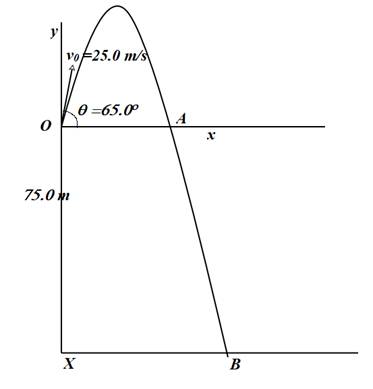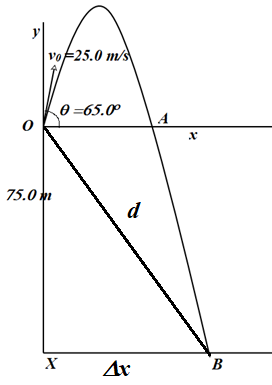
Concept explainers
(a)
How long after throwing the rock, it returns to its original height.
Answer to Problem 67QAP
The rock returns to its original height 4.62 s after it was thrown.
Explanation of Solution
Given:
Speed of the rock
Angle of projection of the rock
Formula used:
The equation of motion for the vertical motion of the rock can be used to determine the time it would take for it to return to the height at which it was projected.
Here,
Calculation:
The rock is projected from point O, where the origin of the chosen coordinate system rests. The x axis is drawn parallel to the ground and the + y axis points vertically upwards. The rock moves under the action of the gravitational force. The acceleration acting on the rock acts downwards and it is equal to the acceleration of free fall.
The rock moves upwards and reaches the point of maximum height and then descends down to point A, which is at the same height as the point O.
This is shown in the diagram below:

The total vertical displacement made by the rock when it reaches point A is equal to zero.
Therefore,
Calculate the vertical component of the rock's velocity.
Substitute 0 m for
Conclusion:
Thus, the rock returns to its original height 4.62 s after it was thrown.
(b)
When the stone projected from the top of the dam would hit the water flowing out of the dam.
Answer to Problem 67QAP
The stone would hit the water after 6.86 s after it was thrown and the sound of splash would reach us 0.303 s later.
Explanation of Solution
Given:
Height of the dam from the ground
Speed of the rock
Angle of projection of the rock
Speed of sound in air
Formula used:
The equation for the vertical motion of the rock is
Here,
The equation for the horizontal motion of the rock is
Here,
The time taken by sound to reach the point of projection is given by,
Here, d is the total distance traveled by sound with a speed
Calculation:
The vertical component of the rock's velocity, calculated in part (a) is
The total vertical displacement made by the rock when it reaches the water is equal to the height of the dam.
In equation (1), substitute
Rearrange the equation.
Solve for t.
Taking the positive root,
The stone splashes into water at point B, which is at a horizontal distance

No force acts on the rock in the horizontal direction, hence the acceleration
Calculate the horizontal component of the rock's velocity.
Substitute 10.56 m/s for
The sound of splash starts from point B and travels along BO to reach the point of projection.
Calculate the distance travelled by sound.
Calculate the time taken by the sound of splash to reach the point of projection using equation (3).
Conclusion:
Thus, the stone would hit the water after 6.86 s after it was thrown and the sound of splash would reach us 0.303 s later
Want to see more full solutions like this?
Chapter 3 Solutions
COLLEGE PHYSICS
- Please rewrite the rules of Quantum mechanics?arrow_forwardSuppose there are two transformers between your house and the high-voltage transmission line that distributes the power. In addition, assume your house is the only one using electric power. At a substation the primary of a step-down transformer (turns ratio = 1:23) receives the voltage from the high-voltage transmission line. Because of your usage, a current of 51.1 mA exists in the primary of the transformer. The secondary is connected to the primary of another step-down transformer (turns ratio = 1:36) somewhere near your house, perhaps up on a telephone pole. The secondary of this transformer delivers a 240-V emf to your house. How much power is your house using? Remember that the current and voltage given in this problem are rms values.arrow_forwardThe human eye is most sensitive to light having a frequency of about 5.5 × 1014 Hz, which is in the yellow-green region of the electromagnetic spectrum. How many wavelengths of this light can fit across a distance of 2.2 cm?arrow_forward
- A one-dimensional harmonic oscillator of mass m and angular frequency w is in a heat bath of temperature T. What is the root mean square of the displacement of the oscillator? (In the expressions below k is the Boltzmann constant.) Select one: ○ (KT/mw²)1/2 ○ (KT/mw²)-1/2 ○ kT/w O (KT/mw²) 1/2In(2)arrow_forwardTwo polarizers are placed on top of each other so that their transmission axes coincide. If unpolarized light falls on the system, the transmitted intensity is lo. What is the transmitted intensity if one of the polarizers is rotated by 30 degrees? Select one: ○ 10/4 ○ 0.866 lo ○ 310/4 01/2 10/2arrow_forwardBefore attempting this problem, review Conceptual Example 7. The intensity of the light that reaches the photocell in the drawing is 160 W/m², when 0 = 18°. What would be the intensity reaching the photocell if the analyzer were removed from the setup, everything else remaining the same? Light Photocell Polarizer Insert Analyzerarrow_forward
- The lifetime of a muon in its rest frame is 2.2 microseconds. What is the lifetime of the muon measured in the laboratory frame, where the muon's kinetic energy is 53 MeV? It is known that the rest energy of the muon is 106 MeV. Select one: O 4.4 microseconds O 6.6 microseconds O 3.3 microseconds O 1.1 microsecondsarrow_forwardThe Lagrangian of a particle performing harmonic oscil- lations is written in the form L = ax² - Bx² - yx, where a, and are constants. What is the angular frequency of oscillations? A) √2/a B) √(+2a)/B C) √√Ba D) B/αarrow_forwardThe mean temperature of the Earth is T=287 K. What would the new mean temperature T' be if the mean distance between the Earth and the Sun was increased by 2%? Select one: ○ 293 K O 281 K ○ 273 K 284 Karrow_forward
- Two concentric current-carrying wire loops of radius 3 cm and 9 cm lie in the same plane. The currents in the loops flow in the same direction and are equal in magnitude. The magnetic field at the common center of the loops is 50 mT. What would be the value of magnetic field at the center if the direction of the two currents was opposite to each other (but their value is kept constant)? Select one: ○ 20 mT ○ 10 mT O 15 mT ○ 25 mTarrow_forwardAn ideal coil of inductivity 50 mH is connected in series with a resistor of 50 ohm. This system is connected to a 4.5 V battery for a long time. What is the current in the circuit? Select one: O 45 mA ○ 90 mA 00 mA O 150 mAarrow_forwardThere are two thin-walled spherical shells made from the same material, the radius of the smaller shell is half of the radius of the larger one. The thickness of the walls is the same. Denote the moment of inertia (with respect to the center) of the larger shell by I₁, and that of the smaller one by 12. What is the ratio I₁/12? Select one: ○ 8 O 16 O 4 ○ 32arrow_forward
 College PhysicsPhysicsISBN:9781938168000Author:Paul Peter Urone, Roger HinrichsPublisher:OpenStax College
College PhysicsPhysicsISBN:9781938168000Author:Paul Peter Urone, Roger HinrichsPublisher:OpenStax College Principles of Physics: A Calculus-Based TextPhysicsISBN:9781133104261Author:Raymond A. Serway, John W. JewettPublisher:Cengage Learning
Principles of Physics: A Calculus-Based TextPhysicsISBN:9781133104261Author:Raymond A. Serway, John W. JewettPublisher:Cengage Learning Glencoe Physics: Principles and Problems, Student...PhysicsISBN:9780078807213Author:Paul W. ZitzewitzPublisher:Glencoe/McGraw-Hill
Glencoe Physics: Principles and Problems, Student...PhysicsISBN:9780078807213Author:Paul W. ZitzewitzPublisher:Glencoe/McGraw-Hill College PhysicsPhysicsISBN:9781305952300Author:Raymond A. Serway, Chris VuillePublisher:Cengage Learning
College PhysicsPhysicsISBN:9781305952300Author:Raymond A. Serway, Chris VuillePublisher:Cengage Learning Physics for Scientists and Engineers, Technology ...PhysicsISBN:9781305116399Author:Raymond A. Serway, John W. JewettPublisher:Cengage Learning
Physics for Scientists and Engineers, Technology ...PhysicsISBN:9781305116399Author:Raymond A. Serway, John W. JewettPublisher:Cengage Learning Physics for Scientists and Engineers with Modern ...PhysicsISBN:9781337553292Author:Raymond A. Serway, John W. JewettPublisher:Cengage Learning
Physics for Scientists and Engineers with Modern ...PhysicsISBN:9781337553292Author:Raymond A. Serway, John W. JewettPublisher:Cengage Learning





